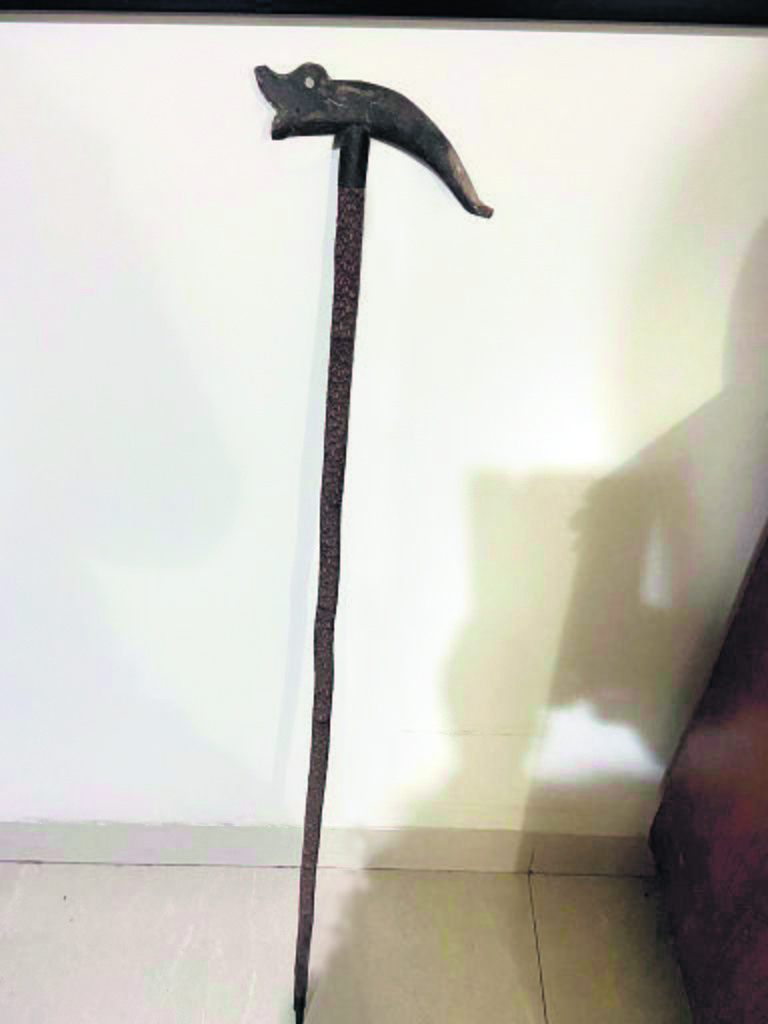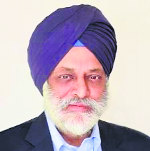
The bramble stick from Turtuk. Photo by the writer
Nehchal Sandhu
JUST the other day, going through memorabilia collected during travels and accumulated in my cache over the years, I came upon a bramble stick presented to me by the headman of Turtuk, a hamlet of about 300 households on the southern (left) bank of the Shyok river in Ladakh. Distinctive it was, with a grip hewn out of the horn of a mountain goat, the shaft a thick wild rose stalk, and a ferrule fashioned out of brass recovered by melting spent rifle ammunition. Never used as a walking stick, it had remained amongst my prized possessions, only to be rediscovered now after nearly four decades.
No worthwhile conversation was possible with the worthy, advanced in years, as he knew only Balti. He produced the second gift — a packet of dried apricots. Turtuk, with its lush buckwheat fields dotted with orange canopies of trees laden with apricots and bisected by a water course running along rough stony paths until a wooden bridge linking the two parts of this habitat, was quite picturesque. The surroundings dominated by stark and lofty peaks capped with snow made for quite a sight. Turtuk, along with nearby Thang, Tyakshi and Chalunka, had been seized by our Army in December 1971. This quaint village had remained culturally and ethnically a part of neighbouring Baltistan and, like Kargil, entirely Shia. The absence then of a motorable link to other parts of Nubra valley contributed to preservation of its distinctive character. Weaving, woodcraft, and fabrication of stone cooking vessels (doltoks), besides agriculture, were the avocations of the residents.
Flying back at mid-day along the Shyok, its crystal clear aquamarine waters revealed rocks of different forms and colours on its bed. In that benign state, this river belied its longstanding epithet “the river of death”. It was difficult to imagine that it had been in spate on five occasions in the 19th and 20th centuries, causing particularly heavy damage in 1835 and 1926, nearly destroying the village of Deskit. Downstream, in the narrow valley near Biagdando through which we flew, the raging flood waters were said to have been 70 feet above the normal level.
With the valley broadening out, we flew nearly 40 km before coming over Hunder. An elongated verdant enclave caressing the Shyok, Hunder was once the capital of the Nubra kingdom. The ruins of the Elephant Palace and a fort above it testify to its connection with the Namgyal dynasty that held sway in Ladakh for nearly 400 years until the mid-19th century. Betwixt the habitation and the dark grey mountains that dominate it in the south lay nearly 5 km of dunes of silvery sand. The sight of double-humped camels lounging amidst the dunes in the mid-day sun was quite unusual. Known as Bactrian camels, these animals are native to the steppes of Central Asia and the Gobi desert and are not found elsewhere in India; there is no explanation as to how they came to be in Nubra. Shorter and heavier than normal camels, their dual humps enable a higher storage of fat that converts to energy when needed. Not too far lay Deskit, the administrative headquarters of Nubra, presiding over the confluence of the relatively short Nubra river with the Shyok; the latter having coursed through 300-plus km from its origin. With allotted helicopter time running out, we headed back to Leh.
A year later, an invitation for witnessing a traditional cultural festival in Partapur came our way. Realising that this might be the only opportunity for the family to visit Nubra valley, we opted for a road journey. The 6,500-foot climb from Leh to Khardung La over 40 km was uneventful; it was only when we emerged from the vehicle that we realised that our unbroken stay of 14 months at 11,000 feet at Leh was not sufficient to prepare our bodies for that altitude and breathlessness had to be endured. Descent from the watershed on a northerly course proved to be tricky as heavy trucks making the ascent to Khardung La had left deep ruts in the slush causing our vehicle to careen often, raising the possibility of plunging to the valley floor thousands of feet below. The terrain relaxed only once we got to the Shyok bed.
Near Deskit, we were treated to the spectacle of a myriad well-formed and short bushes of wild rose, all covered with pink blooms, locally called “Sia”. That sight, with the pink and green of the bushes contrasting sharply with the sand around, remains etched in all its splendour in our memories even today. No wonder Nubra valley is variously described as the “garden of Ladakh”, “valley of colours” and “valley of flowers”. The Deskit monastery established in the 14th century and connected with the Gelugpa sect of Tibetan Buddhism, 700 feet above the village, dominates the Nubra-Shyok confluence and the flat expanse around it.
At Partapur, over a couple of days, Cham and Shondol dances were staged. The former were performed by Tibetan monks with masks and brightly patterned attire to music played on traditional instruments. Ladakhi men and women of the laity performed variations of the latter. A day was set aside for a visit to the hot springs at Panamik on the banks of the Nubra river. Unlike Puga, the waters here were distinctly sulphurous, and are believed to have medicinal properties. With the emphysema of our escort playing up, we had to abandon visits to Ensa Gompa and Yarab Tso, and head home. Despite our brief sojourn, the contrast between the bucolic character of Nubra tehsil and the nomadic pastoralists of other parts of Leh district came forth in sharp relief.
Join Whatsapp Channel of The Tribune for latest updates.




























